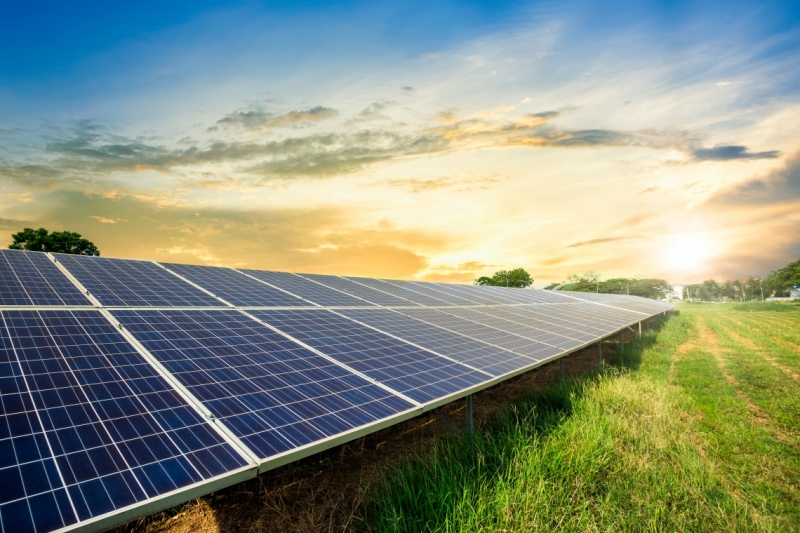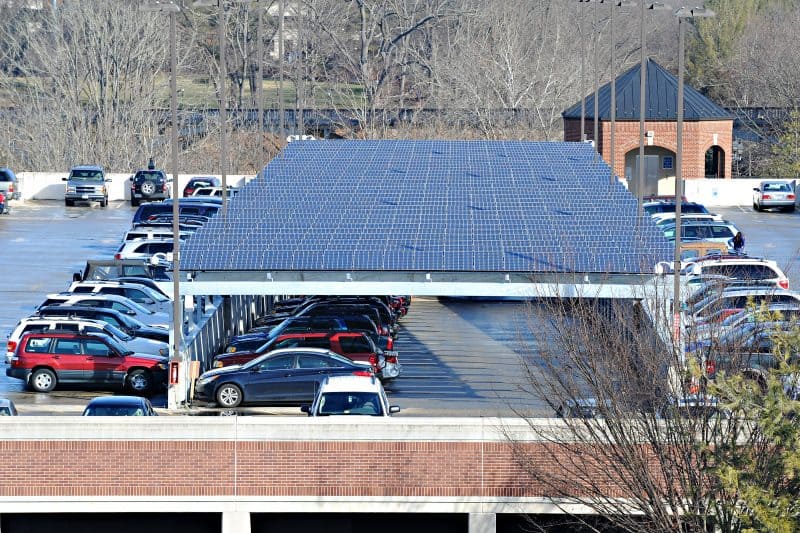W&L to Match 100% of Electricity Use with Solar Energy A new deal will establish an offsite solar farm from which W&L will purchase energy equivalent to 100% of campus electricity use, allowing the university to lower greenhouse gas emissions, save money and close in on its goal of carbon neutrality.
In a continuing commitment to environmental responsibility, Washington and Lee University this week completed a deal to purchase enough solar energy to match 100% of the university’s annual electricity consumption.
The long-term virtual power purchase agreement, which has been several years in the making, establishes a partnership between W&L and solar energy developer SunEnergy1, which will build, own and operate a 17-megawatt offsite solar farm in North Carolina. W&L will purchase the power produced from 11 of those total megawatts, an annual total of over 22,000 MWh, more than enough to match annual campus electricity use. The deal, which was facilitated in partnership with advisory firm CustomerFirst Renewables, allows the university to significantly lower its greenhouse gas emissions, reduce long-term energy cost uncertainty, and accelerate progress to meet its goal of carbon neutrality by 2050.
“This project represents a huge step forward, creating new solar capacity in a way that advances renewable energy in our region, not just on our campus,” said Jane Stewart, director of sustainability at W&L. “Meeting climate-related challenges requires us to widen our perspective and think about systems and solutions in a new way. In committing to this project, W&L has done just that. I am so grateful to our leadership for having the vision and resolve to make this happen.”
Washington and Lee University leadership has long been invested in sustainability, signing the American Colleges and University Presidents’ Climate Commitment in 2007 and establishing a long-term Climate Action Plan in 2010, which was updated in 2019. The university has worked diligently to advance those goals, with a particular focus on reducing campus energy consumption, which represents the biggest portion of the campus carbon footprint.
“We are very proud of the progress we’ve made on our sustainability initiatives in recent years,” said W&L President William C. Dudley. “Thanks to the leadership of Steve McAllister and Jane Stewart, the good work of our university facilities staff and the guidance of the University Sustainability Committee, we have consistently surpassed the original targets outlined in our Climate Action Plan. This new partnership will significantly advance our commitment to attaining carbon neutrality, and we look forward to making further progress through a thoughtful review of purchasing, transportation and sustainable office and living practices.”
Over the last decade, W&L has reduced campus greenhouse gas emissions by 42%. The new solar purchase will cover all emissions associated with campus electricity, bringing that reduction to 63%. Sustainability work at W&L has also saved substantial dollars; today, the university’s annual utility spend is $1 million less than it was in 2007 — despite the expansion of the physical campus — and that money has been used to advance the institution’s strategic goals.
Steve McAllister, W&L’s vice president for finance, said the new solar project is anticipated to generate a net present value gain of $1.8 million over the next 20 years, effectively setting the energy production costs for W&L’s electricity purchase for the next two decades at a level currently below the market rate.
“I can say that in my 20 years as the vice president for finance, this is the most significant agreement that I have had the privilege to enter into,” McAllister said. “This is a very significant development in our efforts to achieve our sustainability goals in meeting our commitments in the President’s Climate Initiatives as well as our ambitions in the Strategic Plan.”
But the project did not happen overnight or come easily. Stewart first began to dream of such a deal in 2016, after attending the annual Higher Education Climate Leadership Summit. By that time, W&L had already installed two solar arrays on campus — one on the roof of Lewis Hall and one on the parking deck. A third, on the student pavilion, has since been added. Although significant, especially for a small institution, those arrays have a capacity of roughly 575 kilowatts, not nearly enough to meet the university’s annual electricity needs.
Virginia utility market regulations prohibit retail customers from having capacity of more than three megawatts of renewable energy per year on-site, so building more on-site arrays — already a difficult proposition because of land constraints — was not a viable solution to meet total campus needs. But a presentation at the 2016 conference, followed by consultation with experts and significant research, inspired Stewart to explore a possible solution by way of the deregulated wholesale energy market. She found that W&L could purchase renewable energy that is fed into the regional power grid, from which the state’s electricity utilities, including Dominion Energy and Appalachian Power, pull. With an adequately sized purchase, W&L could match the full annual campus usage.
Finding a location for a solar farm required significant work, as well. W&L leaders wanted to avoid clearing forested land or negatively impacting native flora and fauna, and they wanted to ensure support from the community around the site. In addition, it felt right to find a solar farm in W&L’s own region to help advance the local renewable energy market.
The final location was found just over the Virginia-North Carolina border in Hertford, North Carolina, which is in the same market region as W&L. The project will be built on former farmland in a region that has embraced solar development. The array, sited on more than 100 acres of land, will generate enough renewable energy to avoid emissions equivalent to electricity consumed by 2,800 U.S. homes. “Our goal was to try and neutralize Scope 2 emissions by 2029, and this will do that in one fell swoop,” Stewart said. Scope 2 emissions are greenhouse gas emissions associated with purchased energy.
In siting the array, Stewart said, the goal is to add pollinator-friendly plants and landscaping. “Using pollinator-friendly planting under large arrays creates a healthy habitat for pollinators as well as birds and local wildlife, and research shows that boosting pollinator productivity this way actually increases crop yields at nearby farms,” she said, “We are trying to be thoughtful about all of these pieces.”
Reaching this deal has required input and support from many corners of W&L.
“Steve McAllister has been an incredible champion throughout, providing essential guidance, support and expertise at every step,” Stewart said. “Without Steve’s leadership, this would have remained just an idea.”
The project also benefited from input and encouragement from faculty and staff stakeholders who shared valuable early input on the approach, including President Will Dudley and University Engineer Brendan Perry.
“We are incredibly excited that through patience, determination and great advisors, we have been able to get to this point,” Stewart said.
According to McAllister, the arrangement would never have been possible without the help of W&L’s advisor, CustomerFirst Renewables — or Jane Stewart.
“Jane has worked tirelessly to help educate the community and explore every possible avenue to find an arrangement that meets sustainability objectives while also being a viable economic model,” McAllister said. “She has found ways to overcome hurdles, identify alternates and find solutions each and every time we thought we had hit a dead end. We often talk about the people difference that sets W&L apart from other institutions, and Jane is absolutely representative of that. I take great pride in being her colleague.”
 Freepik.com photo
Freepik.com photo Solar panels on the upper deck of the W&L parking garage offset energy consumption, but do not generate enough power to fully match campus electricity usage.
Solar panels on the upper deck of the W&L parking garage offset energy consumption, but do not generate enough power to fully match campus electricity usage.
You must be logged in to post a comment.